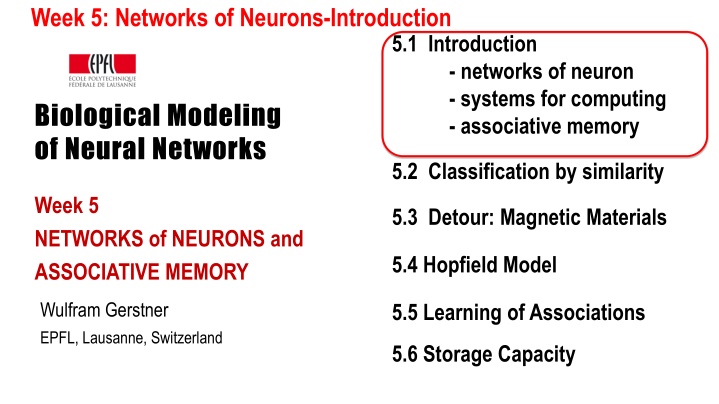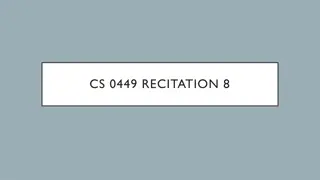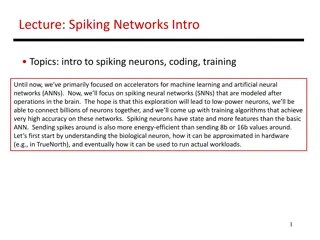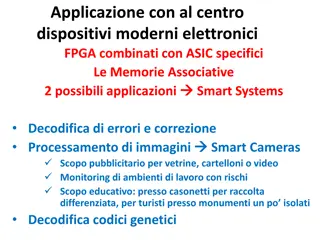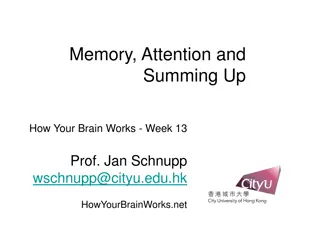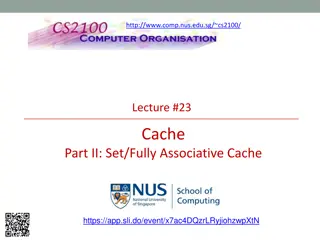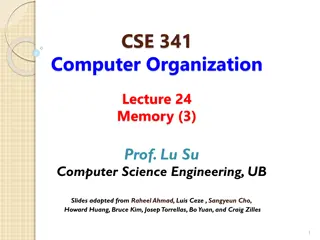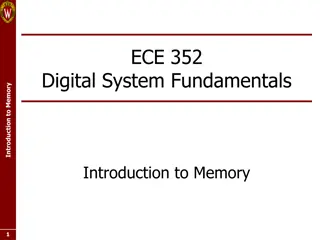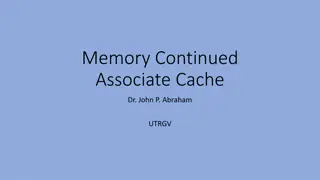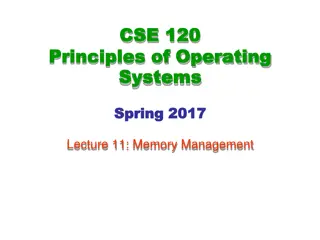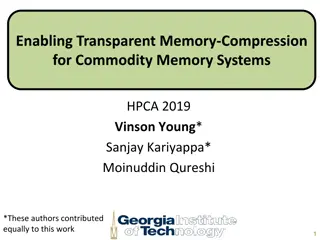Networks of Neurons and Associative Memory: Biological Modeling and Systems for Computing
Dive into the world of networks of neurons and associative memory with insights on biological modeling, systems for computing, and classification by similarity. Explore the fascinating realm of brain-computer memory, distributed architecture, and learning of associations, presented by Wulfram Gerstner from EPFL, Switzerland.
Download Presentation

Please find below an Image/Link to download the presentation.
The content on the website is provided AS IS for your information and personal use only. It may not be sold, licensed, or shared on other websites without obtaining consent from the author.If you encounter any issues during the download, it is possible that the publisher has removed the file from their server.
You are allowed to download the files provided on this website for personal or commercial use, subject to the condition that they are used lawfully. All files are the property of their respective owners.
The content on the website is provided AS IS for your information and personal use only. It may not be sold, licensed, or shared on other websites without obtaining consent from the author.
E N D
Presentation Transcript
Week 5: Networks of Neurons-Introduction 5.1Introduction - networks of neuron - systems for computing - associative memory Biological Modeling of Neural Networks 5.2Classification by similarity 5.3 Detour: Magnetic Materials 5.4 Hopfield Model Week 5 NETWORKS of NEURONS and ASSOCIATIVE MEMORY Wulfram Gerstner EPFL, Lausanne, Switzerland 5.5 Learning of Associations 5.6 Storage Capacity
Systems for computing and information processing Brain Computer memory CPU input Distributed architecture 10 (10 proc. Elements/neurons) No separation of processing and memory Von Neumann architecture 1 CPU 10 (10 transistors)
Systems for computing and information processing 1mm 10 000 neurons 3 km wire
Systems for computing and information processing 1mm Brain 10 000 neurons 3 km wire Distributed architecture 10 10 neurons 4 10 connections/neurons No separation of processing and memory
Associations, Associative Memory Read this text NOW! I find it rea*l* amazin* t*at y*u ar* abl* to re*d t*is tex* despit* th* fac* *hat more t*an t*ent* perc*n* of t** char*cte*s a*e mis*ing. *his mean* t*at you* brai* i* abl* ** fill in missin* info*matio*.
pattern completion/word recognition atom brave brain brass brai* brain Noisy word Your brain fills in missing information: associative memory List of words Output the closest one
Week 5: Networks of Neurons-Introduction 5.1Introduction - networks of neuron - systems for computing - associative memory Biological Modeling of Neural Networks 5.2Classification by similarity 5.3 Detour: Magnetic Materials 5.4 Hopfield Model Week 5 NETWORKS of NEURONS and ASSOCIATIVE MEMORY Wulfram Gerstner EPFL, Lausanne, Switzerland 5.5 Learning of Associations 5.6 Storage Capacity
5.2 Classification by similarity: pattern recognition A B Classification: comparison with prototypes image T Z Noisy image Prototypes
5.2 Classification by similarity: pattern recognition Classification by closest prototype Blackboard: T A x p x p Noisy image Prototypes
5.2 pattern recognition and Pattern completion Aim: Understand Associative Memory Associative memory/ collective computation Noisy image Full image Partial word Full word Brain-style computation
Quiz 5.1: Connectivity A typical neuron in the brain makes connections -To 6-20 neighbors -To 100-200 neurons nearby -To more than 1000 neurons nearby -To more than 1000 neurons nearby or far away. In a typical cristal in nature, each atom interacts -with 6-20 neighbors -with 100-200 neurons nearby -with more than 1000 neurons nearby -with more than 1000 neurons nearby or far away.
Week 5: Networks of Neurons-Introduction 5.1Introduction - networks of neuron - systems for computing - associative memory Biological Modeling of Neural Networks 5.2Classification by similarity 5.3 Detour: Magnetic Materials 5.4 Hopfield Model Week 5 NETWORKS of NEURONS and ASSOCIATIVE MEMORY Wulfram Gerstner EPFL, Lausanne, Switzerland 5.5 Learning of Associations 5.6 Storage Capacity
5.3 Detour: magnetism Noisy magnet pure magnet
5.3 Detour: magnetism Elementary magnet Si= +1 Si= -1 Blackboard: example dynamics ( i S t + = 1) sgn[ ( )] S t j j Sum over all interactions with i
5.3 Detour: magnetism Anti-ferromagnet Elementary magnet Si= +1 Si= -1 wij= +1 wij= -1 dynamics ( i S t + = 1) sgn[ ( )] w S t ij j j Sum over all interactions with i blackboard
5.3 Magnetism and memory patterns blackboard Elementary pixel Si= +1 Si= -1 wij= +1 wij= +1 wij= -1 dynamics ( i S t + = 1) sgn[ ( )] w S t ij j j Hopfield model: Several patterns next section Sum over all interactions with i
Exercise 1: Associative memory (1 pattern) Elementary pixel Si= +1 Si= -1 Next lecture at 10h15 wij= +1 wij= +1 dynamics ( i S t + = 1) sgn[ ( )] w S t ij j 9 neurons - define appropriate weights - what happens if one neuron wrong? - what happens if n neurons wrong? j Sum over all interactions with i
Week 5: Networks of Neurons-Introduction 5.1Introduction - networks of neuron - systems for computing - associative memory Biological Modeling of Neural Networks 5.2Classification by similarity 5.3 Detour: Magnetic Materials 5.4 Hopfield Model Week 5 NETWORKS of NEURONS and ASSOCIATIVE MEMORY Wulfram Gerstner EPFL, Lausanne, Switzerland 5.5 Learning of Associations 5.6 Storage Capacity
5.4 Hopfield Model of Associative Memory interactions i j = w p p ij Sum over all prototypes dynamics sgn[ Prototype p2 Prototype p1 + = ( 1) ( )] S t w S t i ij j j Hopfield model Sum over all interactions with i
5.4 Hopfield Model of Associative Memory This rule is very good for random patterns interactions i j = w p p ij It does not work well for correlated patters Sum over all prototypes Prototype p1 dynamics ( i S t DEMO + = 1) sgn[ ( )] w S t ij j j Random patterns, fully connected: Hopfield model all interactions with i
5.4 Hopfield Model of Associative Memory + = ( 1) sgn[ ( )] S t w S t i ij j j i j = w p p ij 1 N Blackboard ( ) t = ( ) m t S overlap j j 1 N ( ) + = + ( 1) 1 m t S t j j
5.4 Hopfield Model of Associative Memory Interacting neurons Prototype p1 Finds the closest prototype i.e. maximal overlap (similarity) m Computation - without CPU, - without explicit memory unit Hopfield model
Exercise 3 (now) Next lecture at 11h15 = sgn[ w p p 1 N ij i j + = ( 1) ( )] S t w S t i ij j j Sum over all interactions with i Prototype p1 Assume 4 patterns. At time t=0, overlap with Pattern 3, no overlap with other patterns. discuss temporal evolution (of overlaps) (assume that patterns are orthogonal)
Week 5-5: Learning of Associations 5.1Introduction - networks of neuron - systems for computing - associative memory Biological Modeling of Neural Networks 5.2Classification by similarity 5.3 Detour: Magnetic Materials 5.4 Hopfield Model Week 5 NETWORKS of NEURONS and ASSOCIATIVE MEMORY Wulfram Gerstner EPFL, Lausanne, Switzerland 5.5 Learning of Associations 5.6 Storage Capacity
5.5 Learning of Associations Where do the connections come from? pre j ij w i k post Hebbian Learning When an axon of cell j repeatedly or persistently takes part in firing cell i, then j s efficiency as one of the cells firing i is increased Hebb, 1949 - local rule - simultaneously active (correlations)
5.5 Hebbian Learning of Associations item memorized
5.5 Hebbian Learning: Associative Recall Recall: Partial info item recalled
5.5 Associative Recall Tell me the color Tell me the object shape for the following list of 5 items: for the following list of 5 items: be as fast as possible: time
5.5 Associative Recall Tell me the color for the following list of 5 items: Red Blue Yellow Green Red be as fast as possible: time Stroop effect: Slow response: hard to work Against natural associations
5.5 Associative Recall Hierarchical organization of Associative memory animals fish birds Name as fast as possible an example of a bird swan (or goose or raven or ) Write down first letter: s for swan or r for raven
5.5 Associative Recall Nommez au plus vite possible un exemple d un /d une name as fast as possible an example of a tool color fruit hammer outil couleur fruit instrument de musique red Apple music instrument violin
Week 5-5: Learning of Associations 5.1Introduction - networks of neuron - systems for computing - associative memory Biological Modeling of Neural Networks 5.2Classification by similarity 5.3 Detour: Magnetic Materials 5.4 Hopfield Model Week 5 NETWORKS of NEURONS and ASSOCIATIVE MEMORY Wulfram Gerstner EPFL, Lausanne, Switzerland 5.5 Learning of Associations 5.6 Storage Capacity
learning of prototypes interactions =1 i j (1) w p p ij N Prototype p2 Prototype p1 Sum over all prototypes Q; How many prototypes can be stored? + = ( 1) sgn[ ( )] S t w S t dynamics i ij j j all interactions with i
Q; How many prototypes can be stored? blackboard Random patterns w i j = p p Interactions (1) Prototype p2 Dynamics (2) Prototype p1 ij + = ( 1) sgn[ ( )] S t w S t i ij j j Minimal condition: pattern is fixed point of dynamics -Assume we start directly in one pattern -Pattern stays Attention: Retrieval requires more (pattern completion)
Exercise 4 now: Associative memory Q; How many prototypes can be stored? End of lecture, exercise+ Computer exercise : 12:00 w Interactions (1) i j = p p Prototype p2 Dynamics (2) Prototype p1 ij + = ( 1) sgn[ ( )] S t w S t i ij j j Random patterns random walk a) show relation to erf function: importance of p/N b) network of 1000 neurons allow at most 1 wrong pixel? c) network of N neurons at most 1 promille wrong pixels?
Week 6 Review: storage capacity of Hopfield model Random patterns i j = w p p Interactions (1) Prototype p2 Dynamics (2) Prototype p1 ij + = ( 1) sgn[ ( )] S t w S t i ij j j Minimal condition: pattern is fixed point of dynamics -Assume we start directly in one pattern -Pattern stays Attention: Retrieval requires more (pattern completion)
Q; How many prototypes can be stored? error P 0 1
Week 6: Hopfield model continued Biological Modeling of Neural Networks 6.1 Stochastic Hopfield Model 6.2. Energy landscape 6.3. Low-activity patterns 6.4. Attractor memorie - spiking neurons - experimental data Week 6 Hebbian LEARNING and ASSOCIATIVE MEMORY Wulfram Gerstner EPFL, Lausanne, Switzerland
6.1 Review: Hopfield model interactions i j =1 (1) w p p ij N Prototype p2 Prototype p1 Sum over all prototypes Deterministic dynamics + = ( 1) sgn[ ( )] S t w S t i ij j j
6.1 Stochastic Hopfield model Random patterns i j = w p p Interactions (1) Prototype p2 Prototype p1 ij Dynamics (2) ( ) t + = + = = Pr{ ( 1) 1| } h [ ] g h S t g w S i i i j ij j ( ) t + = + = Pr{ ( 1) 1| } h S t g p m blackboard i i i
6.1 Stochastic Hopfield model: memory retrieval + ( ) m t t ( ) t m ( ) m t 0
6.1 Stochastic Hopfield model: memory retrieval = 17 1 m m = 3 1
6.1 Stochastic Hopfield model Dynamics (2) ( ) t + = + = = Pr{ ( 1) 1| } h [ ] g h S t g w S i i i j ij j ( ) t + = + = Pr{ ( 1) 1| } h S t g p m i i i blackboard Assume that there is only overlap with pattern 17: two groups of neurons: those that should be on and off Pr{ ( 1) 1| } i i S t h h + = + = = + = + = = ( ) t g m g + 17 ( ) t 17 Pr{ ( 1) 1| } S t h h m i i ( ) t ( ) t ( ) t ( ) t g m g m + = + 17 17 17 17 17 2 ( 1) {1 } {1 } m t g m g m
6.1 Stochastic Hopfield model: memory retrieval ( ) 2 ( 1) {1 m t g m t g + = + ( ) ( 1) m t F m t + = ( ) t ( ) t ( ) t g m 17 17 17 17 17 } {1 } m g m 17 17 + ( ) m t t ( ) t m ( ) t m 0
Week 6: Hopfield model continued Biological Modeling of Neural Networks 6.1 Stochastic Hopfield Model 6.2. Energy landscape 6.3. Low-activity patterns 6.4. Attractor memorie - spiking neurons - experimental data Week 6 Hebbian LEARNING and ASSOCIATIVE MEMORY Wulfram Gerstner EPFL, Lausanne, Switzerland
6.2 memory retrieval m = 17 1 m = 3 1
6.2 Symmetric interactions: Energy picture E = 17 1 m m = 3 1
Exercise 2 now: Energy picture E ( i S t + Next lecture 11:25 = 1) sgn[ ( )] w S t ij j j = E w S S ij i j i j = 17 1 m m = 3 1
